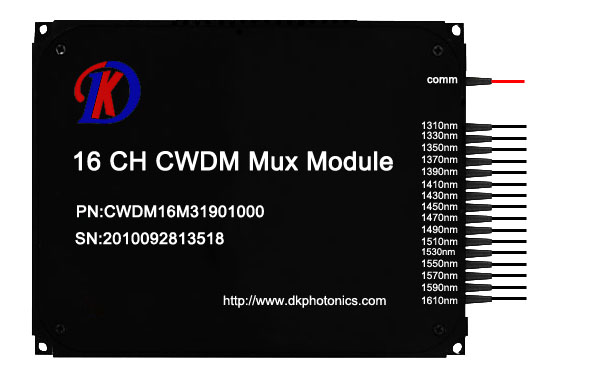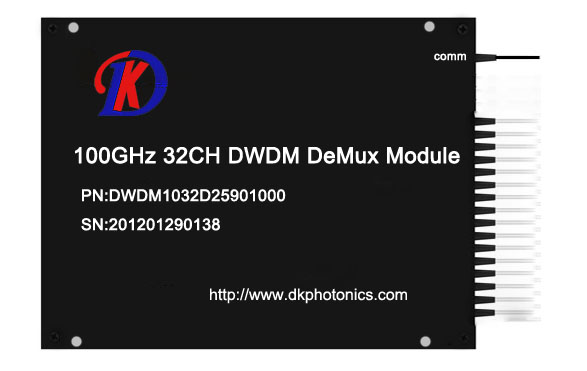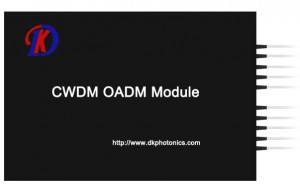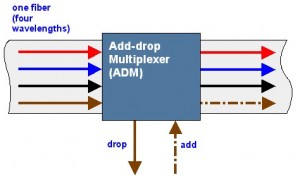What is WDM?
In the same optical fiber at the same time can let two or more than two wavelength signal transmit and receive information through different optical channel, called wavelength division multiplex, referred to as WDM. Wavelength division multiplexing includes frequency division multiplexing and wavelength division multiplexing. Optical frequency division multiplexing (FDM) technology and optical wavelength division multiplexing (WDM) technology has no obvious difference, because the light is part of the electromagnetic wave, frequency and wavelength of light have a single correspondence. Usually also can understand so, optical frequency division multiplexing mean subdivision of optical frequency, very dense optical channel. Wavelength division multiplexing means divided frequency of light, light channel far apart, even in the optical fiber with different window.
The general application of division multiplexing wavelength is respectively using a wavelength division multiplexer and demultiplexer arranged at both ends of the optical fiber, coupling and separation of different wavelength. The main four types of WDM are fused biconical taper type, dielectric film type, FBG type and planar waveguide grating type .The main characteristic is the insertion loss and isolation. Usually, the optical link using wavelength division multiplexing equipment, increase the amount of optical link loss is called WDM insertion loss. When the wavelength transmission through the same optical fiber, the D-value between the splitter input mixed power and the output end of the fiber power is called isolation.. The following are characteristics and advantages of optical wavelength division multiplexing technical:
(1) Make full use of low loss band fiber, increase the transmission capacity of optical fiber, the physical limit of an optical fiber for transmitting information doubled to several times. At present, we only use the low loss optical fiber spectrum (1310nm-1550nm) a few, WDM can fully utilize the huge bandwidth of single-mode fiber is about 25THz, the transmission bandwidth is sufficient.
(2) There are ability to transmit two or more than two asynchronous signal in the same optical fiber ,there are compatible for digital and analog signals, has nothing to do with the data rate and modulation mode, the middle line can be removed or added channel.
(3) About the optical fiber system that has built, especially early laying optical cable that core number not much, as long as the original system power is margin, we can increase the capacity; realize the transmission of multiple one-way or two-way signals without making big changes to the original system, so it has strong flexibility.
(4) Due to the large number of reducing use amount of the fiber, it can greatly reduce the construction cost, because the fiber quantity is less, when a fault occurs, the recovery is also fast and convenient.
(5) Sharing of active optical devices, the cost of transmission of multiple signals or increase new business will reduce.
(6)The active devices in the system have been substantially reduced, which improves the reliability of the system. At present, because of the light multi carrier division multiplexing of optical transmitter, optical receiver equipment’s requirements higher, technology implementation has certain difficulty, also multiple core cable used in traditional broadcast television transmission business does not appear especially shortage, so the practical application of WDM is still not much. However, with the development of CATV integrated service development, the growing demand for network bandwidth, all kinds of selective service upgrade and network implementation economic cost considerations and so on, the characteristics and advantages of WDM in the CATV transmission system gradually emerged, showing broad application prospects, even influence the development pattern of CATV network.
What Is the Difference Between DWDM and CWDM Optical Technologies?
DWDM (dense wavelength division multiplexing) is undoubtedly the first choice technology in the field of fiber optic applications today, But the cause of high cost make many do not bounteous operators hesitating. Is there a lower cost for using the wavelength division multiplexing technology? In the face of this demand, CWDM (coarse wavelength division multiplexing) emerges as the times require.
CWDM, just as its name implies, is a dense wavelength division multiplexing next of kin, the difference between CWDM and DWDM mainly has two points: first, the CWDM carrier channel spacing is wider, therefore, light in a single fiber can reuse about 5 to 6 wavelengths, that is where the “dense” and “coarse” appellation come from; Two, CWDM modulation laser using uncooled laser, but DWDM is used in cooling laser. Cooling laser using temperature tuning, uncooled laser adopts electronic tuning. Because the range of temperature distribution is nonuniform in a very wide wavelength, so the temperature tuning is very difficult to realize, the cost is very high. CWDM avoids this problem, so it greatly reduces the cost; the whole CWDM system cost only 30% of DWDM.
CWDM provides a very high access bandwidth with a low cost, suitable for point to point, Ethernet, SONET rings and all kinds of popular network structure, especially suitable for short distance, high bandwidth, access point intensive, communication applications, such as network communication between the building or building. It is particularly worth mentioning is that CWDM with the use of PON (passive optical network).PON is a cheap, one-point to multi-point optical fiber communication mode, in combination with the CWDM, each individual wavelength channel can be used as virtual optical link of PON, Implementation of broadband data transmission between center node and multiple distributed nodes.
There are several companies are offering CWDM related products at present. However, CWDM is a product of cost and performance tradeoffs; inevitably there are some performance limitations. Industry experts point out, at present the CWDM have four following disadvantages: first, CWDM in a single fiber support multiplexing wavelength number is minor, leading to future expansion cost is high; second, multiplexing, multiplexing equipment cost should also be reduced, the device cannot be simply modified of DWDM corresponding equipment; third, CWDM does not apply to metropolitan area network, the distance between metropolitan area network nodes is short , the money that operators use in CWDM equipment expansion can be used to laying more fiber, and get better effect; fourth, CWDM has not yet formed standards.
What’s more, something about the WDM products.
(1)CWDM Mux/Demux module
CWDM Mux and CWDM Demux are designed to multiplex multiple CWDM channels into one or two fibers. The core of CWDM Module application is the passive MUX DEMUX unit. The common configuration is 1×4, 1×8, 1×16 channels. Available in 19″ Rack Mount or LGX module package. Optional wide band port is available to multiplex with CWDM Channels wavelength.
(2)DWDM Mux/Demux Modules
DWDM Mux and DWDM DeMux are designed to multiplex multiple DWDM channels into one or two fibers. The common configuration is 4, 8, 16 and 40 channels. These modules passively multiplex the optical signal outputs from 4 or more electronic devices, send them over a single optical fiber and then de-multiplex the signals into separate, distinct signals for input into electronic devices at the other end of the fiber optic link
(3)Optical Splitter– a important component in EPON network
Optical splitter in optical communication era is a component of EPON network construction, is a connection of OLT and ONU passive device.
Its function is to distribute the downlink data, and focus on the uplink data. Optical splitter has an upstream optical interface, a plurality of downlink optical interface. Optical signals from the upstream optical interface over was assigned to the downstream optical interface out all transmissions, optical signals from the downlink optical interface over being allocated to uplink optical interface out transmission only. The light intensity signal downlink optical interface of each can be same, can also be different.






